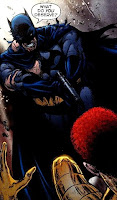Today's key word:
motif - a recurring element, theme or pattern in a film or text that has a wider significance
What's the purpose?
Preparing for your film shoot next week where you'll be shooting your own film noir scene, you'll need to understand how to write a typical noir scene.
You'll work in pairs today as scriptwriters, using a scene from what many critics consider to be the first noir film, The Maltese Falcon (Huston, 1941) as a starting point for your writing.
We'll use the best scripts next week to shoot your scenes.
1) Watch the trailer for The Maltese Falcon, to get a "feel" for the film:
Discuss as class: What recognizable FILM NOIR motifs can we find from watching the trailer?
Task 2:
a) Watch the clip shown on the whiteboard from the opening scene of The Maltese Falcon, where Sam Spade (Bogart) meets Ms Wanderlay (Astor) for the first time.
b) Read the following opening to a noir story.
What similarities do the two opening scenes have? What differences? Do you think the Wanderlay character is a reliable person in The Maltese Falcon? Why (not)? What about Sam Spade? Discuss in pairs and write a blog entry, using the same title as this entry, and labelling it Film Noir.
Scriptwriting pairs:
Santos and Ernesto
Manuel and Viveka
Ramiro and Tomas
Carlos and Sabrina
Giuliana and Honorio
Task 3:
Writing your own film noir scene.
As you can see from what we've watched/read already, there are some essential motifs in Film Noir. You need to embrace these to give YOUR scene that authentic noir sensibility:
 |
| Batman - hero with identity issues |
The first thing there's needs to be is an Anti-Hero. He could be a Private Detective - that's certainly one of the more popular options. (You could subvert this classic motif by making your He a She.)
 |
| "Could I smoke a cigarette seductively before I look at these photos of my dead husband?" |
You need to have a Femme Fatale. It's a classic motif in Noir. You know the type. Dressed all in black with legs up to here, she slinks into the PI's office, holding a cigarette on a long, long, holder, saying "Oh, Mr. Rockhammer, you're the only one who can help me find out who killed my extremely wealthy husband." Did she do it? Do I care? Where'd that saxophone music come from? Whatever her story is, whether she did it or not, she's definitely keeping some secrets.
The important thing is is that the world is very cynical. There aren't going to be any happy endings here, at least not for some people: it's usually a horrible place where the pessimistic notion of "anything that can go wrong will go horribly wrong" almost always applies, and it corrupts its inhabitants into perpetuating that nastiness against each other. More succinctly, trying to survive in one of these places is going to suck; humans are either bastards or morons or a combination of the two.
Plot:
Taking on board the private detective anti-hero, the plot may well involve an initial request from the femme fatale to find someone or have someone followed. Usually, though, the initial request turns out to be a lie.
Setting:
Bars are good, an alleyway too, as well as a private detective's office. Anywhere that can be dark and claustrophobic. REMEMBER your scene will be shot INSIDE though - so we can experiment with lighting.
With this background knowledge, you're ready to write your short scene. The final version will need to be posted on your blogs. You have the rest of the lesson to discuss and begin writing.
You will have twenty min of next lesson to complete and publish.
Take a look in the downloads section of Figaro for reminders of how to format your script:
college\IB Film Studies\Screenplays - Halloween document
No comments:
Post a Comment